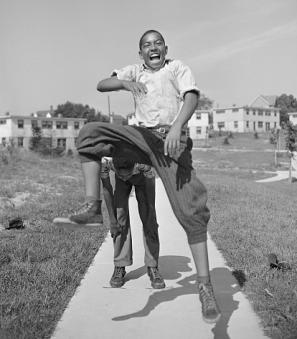The American Hitler Comes to Washington
On a rainy Tuesday morning in February 1940, William Dudley Pelley appeared in Washington to testify before the House Un-American Activities Committee.[1] The appearance was a complete surprise - Pelley had been hiding from both the committee and parole officers in North Carolina for five months prior to his sudden arrival.[2] After months of scandal and sabotage, the “American Hitler” had come to say his piece.
Pelley first came onto the national stage as a writer and publisher. He was unusually prolific, penning hundreds of short stories as well as numerous successful novels, screenplays, and articles.[3] In 1920, his short story, The Face in the Window, was one of the winners of the prestigious O. Henry Prize.[4] He was also an unapologetic racist, anti-Semite, and conspiracy theorist. Following a YMCA-sponsored trip to Russia at the onset of the country’s revolution, Pelley became convinced that the Bolshevik uprising was somehow the product of a vast Jewish conspiracy.[5] Pelley’s politics were consumed by antisemitic paranoia; he alleged that American calamities like the Civil War and the Great Depression could be attributed to vast Jewish conspiracies and that Franklin Delano Roosevelt was secretly a Sephardic Jew plotting to destroy America.[6]
On January 31, 1933, Pelley founded the fascist Silver Legion of America.[7] From the very beginning of the organization, Pelley made it clear that his organization was patterned off of the Nazi model. The Legion was officially founded one day after Hitler became chancellor of Germany and the organization borrowed many of the trappings of the European fascist parties.
Like the brown and blackshirts that violently propelled Hitler and Mussolini into power, the Legion’s Silver Shirts wore a simple monochromatic uniform and dedicated themselves to the Chief (a title reminiscent of other self-aggrandizing fascist appellations like Führer, Duce, and Caudillo).[8] Also like their European counterparts, the Legion maintained a thin veneer of legitimacy over a threat of political violence. Among the group’s goals was “to suddenly become an active, dynamic, vigilante organization that shall not only take definite measures against the present lawless and predatory elements rampant throughout our debauched and distressed country today, but put in political office men from its own ranks, pledged to its own principles, who shall carry out a startling innovation in the furtherance of our American Democracy.”[9] In 1936, Pelley ran for president as the candidate for his own Christian Party of America.[10] Although he would later deny it before the House Committee, he stated in his campaign speeches that “the time has come for an American Hitler and a pogrom.”[11]
It was not long before Pelley’s embrace of violent insurrection attracted the attention of authorities. At their peak of popularity in 1934, the Silver Shirts likely had around fifteen thousand active members and more than seventy-five thousand sympathizers across the United States.[12] Although rising tensions with Germany caused Pelley’s popularity to sharply decline over the course of the decade, the possibility of a Silver Shirt putsch made Pelley and his followers the subject of significant federal and state scrutiny.[13] The growing threat of extremist violence spurred the creation of the Special House Congressional Subcommittee on Un-American Activities in March 1934 and made Pelley’s brand of homegrown fascism one of the public faces of suspected “Un-American” activity.[14] Five years later, HUAC called Pelley to Washington to explain his group’s actions.[15]
In the months between the summons and his sudden arrival in Washington in February 1940, Pelley turned the committee’s request into a national spectacle. Rather than appear promptly before the panel, the aspiring American Hitler went into hiding, publishing articles in his magazine Liberation describing his evasion of the congressional probe.[16] In September 1939, Pelley sued the individual members of the HUAC for a total of over $3,150,000 for supposedly defaming and attempting to falsely incriminate him.[17] Pelley’s defiance of the HUAC only increased the heat on him, as he was still on parole for a 1935 securities fraud conviction in North Carolina.[18] In October, 1939, Pelley was subpoenaed by the Superior Court of Buncombe County and a warrant was issued for his arrest after he could not be found in the state.[19] For five months, the American Hitler remained in hiding, whiling away his time until a new scandal finally forced him to face the HUAC’s scrutinee.
In the fall of 1939, a HUAC subcommittee chaired by Representative Jerry Voorhis paid David Mayne, one of Pelley’s main associates in Washington, to travel North Carolina to find the whereabouts of the elusive fascist.[20] However, Mayne had his own plans for the committee. In the fall of 1940, Mayne forged a series of letters between Pelley and Representative Martin Dies, Jr., the HUAC chair, suggesting that the congressman was secretly colluding with the American Hitler to protect the Silver Shirts from governmental action.[21] These forged letters took a roundabout path into the office of Representative Hook of Michigan, who created a political firestorm when he attempted to discredit the committee by entering the letters into the Congressional Record on January 22.[22]
The allegation that one of the highest investigative bodies in the nation was secretly collaborating with militant fascists immediately created a scandal, one that only intensified when it was revealed that Mayne had forged the documents. A Washington Post article from February 1st includes a quotation from Representative Keefe of Wisconsin, who demanded an apology from Hook with the warning that “The integrity of this House is at stake.”[23] According to the historian Scott Beekman, it seems unlikely that Pelley was involved in Mayne’s plot to discredit the HUAC.[24] However, the ongoing damage to his reputation and legal standing could not have escaped Pelley, as he almost immediately made his way to Washington to give his own statement on the events.
On February 6th, Pelley walked into the offices of the HUAC after months of evading congressional subpoenas and surrendered himself to a presumably surprised clerk.[25] That day, Pelley made sure to emphasize that he had no role in the forgery, testifying before a House Rules subcommittee that “None of those letters were written by me, or signed by me.”[26] Moreover, Pelley was compelled to testify before the HUAC later that week, giving testimony on February 7th, 8th and 10th.[27]
The dramatic nature of Pelley’s arrival caused an immediate public stir. Coming right on the heels of the headline-grabbing Mayne scandal, Pelley’s testimony became a major focus of attention both in Washington and the wider nation. For the entirety of the American Hitler’s time before the HUAC, The Evening Star devoted front page articles to the Pelley story. Not to be outdone, the Washington Post ran a full-page spread in its Sunday edition, complete with a cartoon showing Pelley’s admiration of Hitler, seven-minute death and resurrection, and his arrival in Washington.[28] An article under that banner described Pelley as a “master showman” and proclaimed that “Pelley gave Washington its biggest sensation of the week by surrendering himself to the Dies Committee – and its biggest laugh of the week by the manner in which he promptly jumped on the committee’s lap, as someone said, ‘like an unwelcome dog.’”[29]
By February 1940, the Second World War had been raging for over five months. Indeed, the Star’s account of Pelley’s arrival in Washington shared space with the announcement that Britain would begin meat rationing and a report on the latest developments in the Soviet invasion of Finland.[30] Although the United States had not yet entered the war, the horrors occurring in Europe led to new fears of a “fifth column” of fascist and communist sympathizers overthrowing the standing government.[31] Pelley, with his open praise of Hitler and previous attempts to subvert the American government, became a central target of this new public anxiety.
Pelley’s statements before the House Committee can be roughly divided into three categories: fawning praise for the HUAC’s work, duplicitous backpedaling regarding his previous public statements, and thinly-veiled fascist prosletyzing. In his testimony, Pelley attempted to present himself as a very different person than the one who had sued the Committees in September. Pelley repeatedly extolled the virtues of the HUAC and its members, even promising that he would “fold up” the Silver Shirts if the committee would continue targeting communists.[32] However, the members of the committee were not impressed by Pelley’s sudden admiration. On February 9th, the Evening Star reported that “During a recess, one committee-man, half angry and half disgusted, said Mr. Pelley was trying to give the committee ‘the Kiss of Death.”[33] While the American Hitler may have been trying to appear cooperative, his over-the-top exultations were anything but wanted.
When he wasn’t falling over himself to praise the committee, Pelley used his time before the HUAC to try to soften the appearance of his extremist views without actually renouncing those ideals. When questioned regarding a 1938 article published in his magazine that suggested the ghettoization and sterilization of Jewish Americans, Pelley denied a personal hatred for Jews but defended the statement as “…my personal solution for something that we have all got to face before we get through – before many years longer in the United States, I think.” [34] Likewise, Pelley repeatedly insisted that the Silver Shirts always respected the American Constitution, but also quietly admitted that his plans for revolution involved taking control of the government to enact the segregation of Jewish Americans.[35]
Pelley’s extremist statements eventually exceeded the Committee’s tolerance. On February 10th, the final day of his testimony, Pelley made headlines by calling for the lifetime imprisonment of Senator Robert La Follette of Wisconsin, Representative Samuel Dickstein of New York, and the head of the C.I.O., John L. Lewis.[36] Pelley’s allegations that the men had engaged in “communistic attempts to undermine our Government” were quickly shut down by the acting chairman of the committee, who stated that “The Chair insists that this committee not be made a sounding board to attack any American citizen.”[37]
On February 10th, 1940, the House Un-American Activities Committee concluded their examination of the American Hitler. In his closing statements, the Acting Chairman condemned Pelley for his antisemitism and his willingness to use violence to enact racial and religious segregation “in plainest violation of the simplest rudiments of Americanism.”[38] An article in the Baltimore Sun gives an almost cinematic description Pelley’s conduct after his dismissal:
Pelley sucked slowly upon his cigar as the acting chairman paused.
“This committee,” Starnes said, “has concluded its examination of you. You are hereby released from its subpoena, and you are now at liberty to go.”
Pelley stood up, turned around and walked away from the witness chair and almost into the arms of Detective Sergeant Guy Roan, of the Metropolitan police.[39]
When Pelley had come out of hiding, he still had the outstanding warrant from North Carolina. Pelley spent the next year of his life desperately attempting to fight his extradition to North Carolina. On April 5th, Pelley tried to subpoena Representative Dickstein and Representative Dies, the chairs of the Un-American Investigating Committee and the HUAC respectively, in an attempt to prove that the two had created a conspiracy to smear him.[40] Pelley’s appeals were eventually rejected and he was ordered to return to North Carolina on April 14, 1941.[41] In 1942, Pelley was charged with twelve counts of sedition and was convicted by a federal jury to eleven years in prison.[42] Although he was released in 1950, the American Hitler would never again command the attention of the American public the way he had in the 1930s and ‘40s.
William Dudley Pelley remains evocative today due to what he represents. In Sinclair Lewis’s 1935 novel It Can’t Happen Here, the fictional fascist Berzelius Windrip opens the novel’s eighth chapter with an extended celebration of Pelley and the Silver Shirts as “true knights, even if they did not attain quite all the success they deserved.”[43] Pelley’s trip to Washington is a reminder of a time when fifteen thousand people followed the self-proclaimed American Hitler, a time when everyone wondered whether it could happen here.
Footnotes
- ^ Scott Beekman, William Dudley Pelley: A Life In Right-Wing Extremism and the Occult, (Syracuse, New York: Syracuse University Press, 2005), 132-133.
- ^ Associated Press, “Pelley Appears Before Probers, Denies Dies Link”, Evening Star, Feb. 6, 1940.
- ^ H.G. Jones, “Pelley, William Dudley,” in Dictionary of North Carolina Biography, ed. William S. Powell (Chapel Hill, North Carolina: University of North Carolina Press, 1994), 5:60.
- ^ “Past Winners List,” The O. Henry Prize Stories, Random House, 2013, http://www.randomhouse.com/anchor/ohenry/winners/past.html.
- ^ Kevin J. Harty, “William Dudley Pelley, An American Nazi in King Arthur’s Court,” Arthuriana 26, no. 2 (Summer 2016): 1.
- ^ Beekman, Pelley, 90-91; Harty, Pelley 69
- ^ Suzanne G. Ledeboer, “The Man Who Would Be Hitler,” California History 65, no. 2 (Jun. 1986): 129.
- ^ Harty, 69
- ^ United States Congress House Special Committee on Un-American Activities, “Investigation of un-American propaganda activities in the United States. Hearings before a Special Committee on Un-American Activities, House of Representatives, Seventy-fifth Congress, third session-Seventy-eighth Congress, second session, on H. Res. 282, to investigate (1) the extent, character, and objects of un-American propaganda activities in the United States, (2) the diffusion within the United States of subversive and un-American propaganda that is instigated from foreign countries or of a domestic origin and attacks the principle of the form of government as guaranteed by our Constitution, and (3) all other questions in relation thereto that would aid Congress in any necessary remedial legislation,” (Washington, D.C.: U.S. Government Print Office, 1940), 7233.
- ^ Beekman, 112.
- ^ House Special Committee on Un-American Activites, “Investigation of un-American propaganda activities,” 7260; Lebedoer, “Man Who Would Be Hitler,” 134.
- ^ Beekman, 100.
- ^ Ibid.
- ^ Ibid., 105.
- ^ Ibid., 132.
- ^ Ibid., 133.
- ^ “Pelley Sues Dies and Aides for $3,150,000,” Washington Post, Sep. 10, 1939.
- ^ State v. . Pelley, 20 S.E.2d 850 (N.C. 1942).
- ^ Ibid.
- ^ Lebedoer, “Man Who Would Be Hitler,” 134; John B. Oakes, “House Storm Rages Over Dies Forgery: Voorhis Discloses David Mayne Was Sent to Hunt Pelley On Committee Funds,” Washington Post, Feb. 2, 1940.
- ^ Lebedoer, 134; “His Praise Flusters Dies Inquiry: Capital Ponders a Big Mystery: Why Did He Show Up for Investigation?” Washington Post, Feb. 11, 1940.
- ^ “Forged Letters on Dies: David Mayne Pleads Guilty to Selling False Documents,”New York Times, Jan. 28, 1941; “Votes Dies Inquiry a Year’s Extension After Sharp Clash: Rules Committee Unanimous, but Hook Seeks to Link Chairman With Pelley,”New York Times, Jan. 23, 1940.
- ^ John B. Oakes, “Dies Group Sees Plan to Halt Inquiry: ‘Pelley Letters’ Were Bought for Purpose, Members Charge,” Washington Post, Feb. 1, 1940.
- ^ Beekman, 224.
- ^ Associated Press, “Pelley Appears Before Probers.”
- ^ Ibid.
- ^ Ibid; House Special Committee on Un-American Activities, “Investigation of un-American propaganda activities.”
- ^ “Fantastic Story of W.D. Pelley – America’s Home-Grown ‘Fuehrer’” Washington Post, Feb. 11, 1940.
- ^ John Bertram Oakes, “Arrest May Write Finis to Exploits: Mystic Chief of Silver Shirts Fights Extradition to North Carolina”, Washington Post, Feb. 11, 1940.
- ^ “Pelley Appears Before Probers.”
- ^ Beekman, 124.
- ^ “Investigation of un-American propaganda activities,” 7247.
- ^ Associated Press, “Committee Suspends Further Open Probe Of Pelley Case: Dies Group to Make Complete Study of Silver Shirt Evidence,” Evening Star Feb. 9, 1940.
- ^ “Investigation of un-American propaganda activities,” 7218.
- ^ Ibid., 7289.
- ^ Associated Press, “Pelley Would Jail La Follette, Dickstein and Lewis for Life: Starnes Warns Against Using Un-American Quiz As ‘Sounding Board,’” Evening Star, Feb. 10, 1940.
- ^ “Investigation of un-American propaganda activities,” 7282-7283.
- ^ Ibid., 7332-7333.
- ^ C. P. Trussell, “Pelley Arrested As Dies Probers Finish Hearing Him,” The Sun, Feb. 11, 1940.
- ^ “Pelley to Fight Court’s Order On Extradition: Silver Shirt Chief To Appeal Sending Him to North Carolina,” Washington Post, Apr. 6, 1940.
- ^ “Pelley Must Return To N. C. To Face Charges,” The Sun, Apr. 15, 1941.
- ^ United States v. Pelley, 132 F.2d 170 (7th Cir. 1942)
- ^ Lewis Sinclair, It Can’t Happen Here (New York: Signet Classics, 2014), 76.


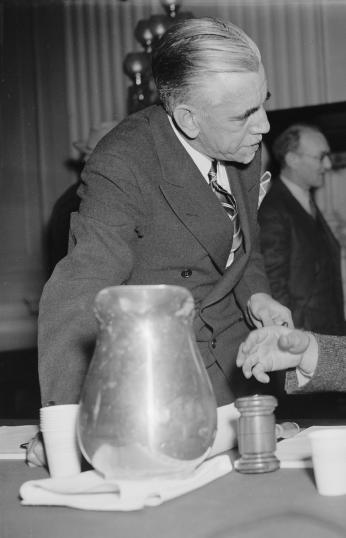
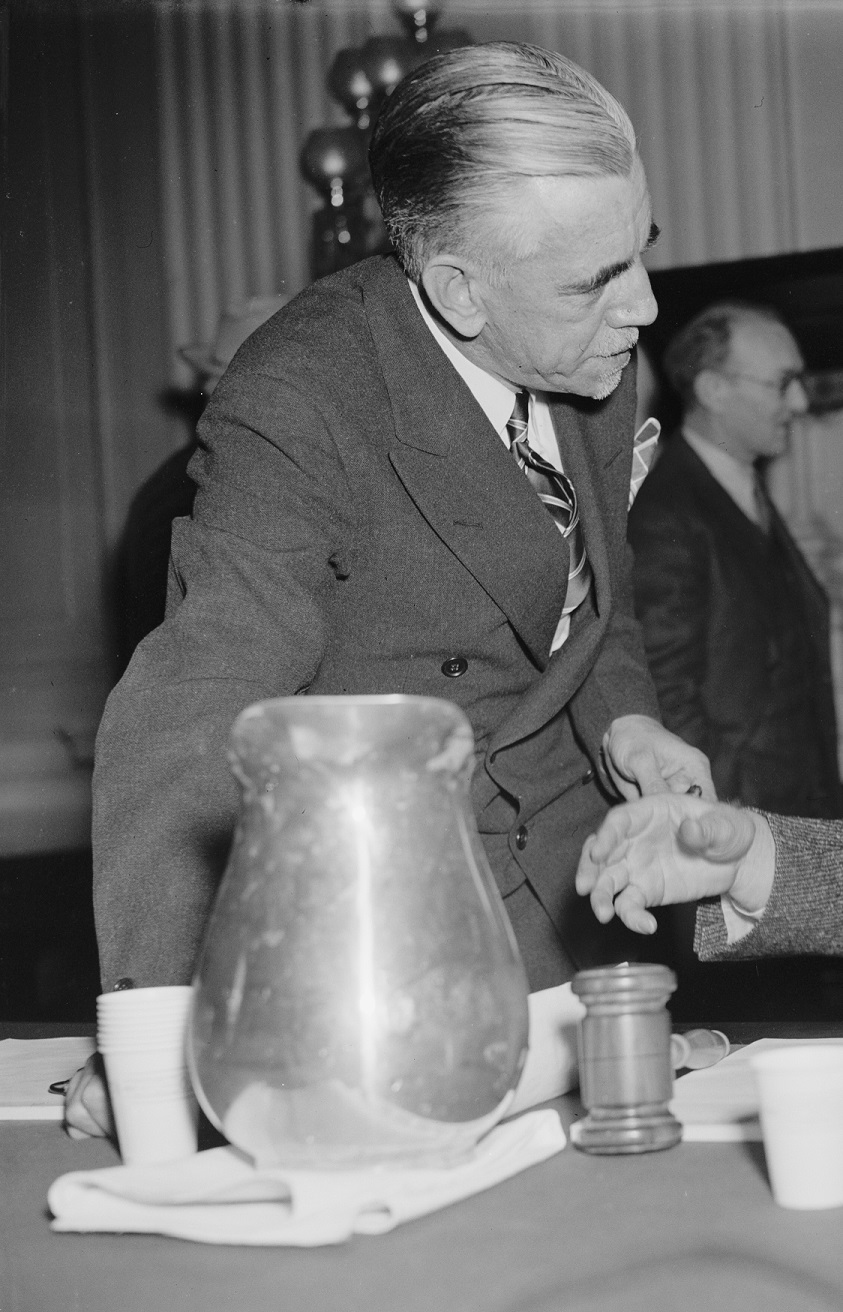
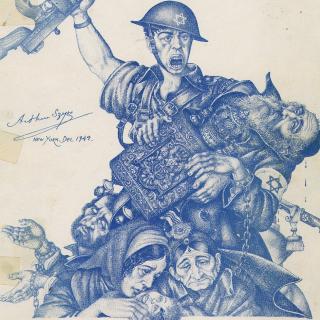
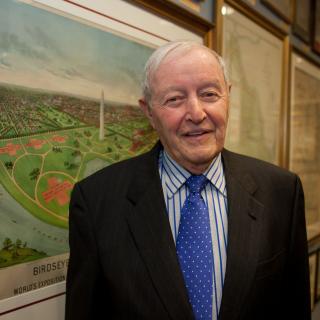
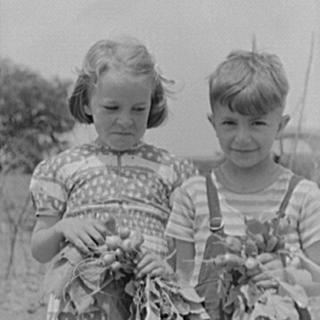
![Sketch of the mythical fuan by Pearson Scott Foresman. [Source: Wikipedia]](/sites/default/files/styles/crop_320x320/public/2023-10/Goatman_Wikipedia_Faun_2_%28PSF%29.png?h=64a074ff&itok=C9Qh-PE1)











